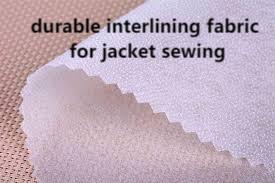In the world of textile manufacturing, there exists a silent yet powerful element that defines the shape, structure, and strength of garments— Interlining . Though it often goes unnoticed by the average consumer, interlining plays a foundational role in apparel design and quality. As the demand for more structured, durable, and aesthetically appealing garments grows, the importance of this material becomes increasingly apparent.
Structural Support That Shapes Every Garment
Behind every sharp collar, crisp cuff, and smooth jacket lapel lies a layer designed to support and shape. This component reinforces the outer fabric, ensuring that form is maintained even with repeated use and washing. Designers rely on this support to create garments that not only look good on the hanger but retain their silhouette on the body, delivering wearability and style in equal measure.
A Range of Applications Across Fabric Types
Whether in formal wear, casual clothing, or even accessories, different base fabrics require unique solutions. The support layer used in a heavy wool suit differs from that in a lightweight cotton shirt. Compatibility with various fabrics—woven, knit, or blended—is a critical consideration in choosing the right internal support. Manufacturers evaluate elasticity, stiffness, and weight to achieve the perfect harmony between flexibility and firmness.
Advancements in Adhesive Technologies and Fabric Innovation
Modern manufacturing methods have revolutionized how internal support materials are applied. Heat-fusible options, once limited by fabric type and environmental concerns, now include sustainable adhesive systems that reduce waste and increase production efficiency. These innovations allow for seamless integration into automation lines, improving speed and consistency in garment construction.
Moving Beyond Garments: Industrial and Home Applications
While traditionally associated with clothing, this material is increasingly used in home furnishings such as drapery, cushions, and upholstery. In industrial settings, it strengthens components in technical textiles, footwear, and automotive interiors. The adaptability of this layer in both flexible and rigid forms makes it a key material across diverse industries, far beyond fashion.
Choosing the Right Material for Optimal Results
The decision process involves far more than just matching thickness. Factors such as shrinkage resistance, bonding strength, and washing durability all influence long-term product performance. Designers and production managers often test multiple variations to determine which performs best under specific environmental and use conditions. This stage is critical to balancing aesthetics, function, and lifecycle cost.To explore more about the topic and gain practical insight, visit:
https://www.interlining-factory.com/news/what-is-interlining-types-applications-and-more.html

